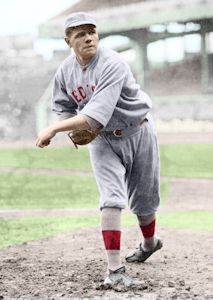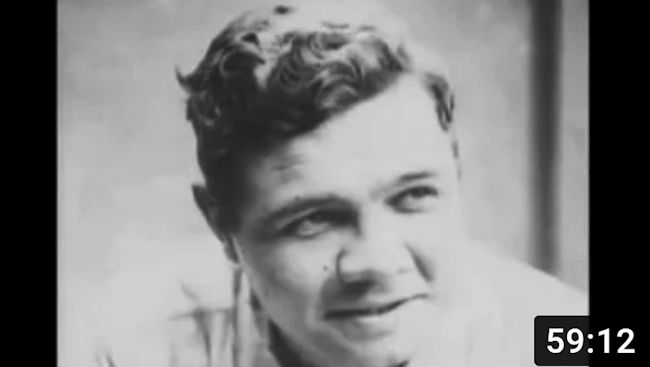 |
|
1914-1919 |
During his five full seasons with the Boston Red Sox, Babe Ruth established himself as one of the premier left-handed pitchers in the game, began his historic transformation from moundsman to slugging outfielder, and was part of three World Series championship teams. After he was sold
to the New York Yankees in December 1919, his eye-popping batting performances over the next few seasons helped usher in a new era of long-distance hitting and high scoring, effectively bringing down the curtain on the Deadball Era.
George Herman Ruth was born to George Ruth and Catherine Schamberger on February 6, 1895, in his mother’s parents’ house at 216 Emory Street, in Baltimore, Maryland. With his father working long hours in his saloon and his mother often in poor health, Little George (as he was known)
spent his days unsupervised on the waterfront streets and docks, committing petty theft and vandalism. Hanging out in his father’s bar, he stole money from the till, drained the last drops from old beer glasses, and developed a taste for chewing tobacco. He was only six years old.
Shortly after his seventh birthday, the Ruths petitioned the Baltimore courts to declare Little George “incorrigible” and sent him to live at St. Mary’s Industrial School, on the outskirts of the city. The boy’s initial stay at St. Mary’s lasted only four weeks before his parents
brought him home for the first of several attempted reconciliations; his long-term residence at St. Mary’s actually began in 1904.
But it was during that first stay that George met Brother Matthias. “He taught me to read and write and he taught me the difference between right and wrong,” Ruth said of the Canadian-born priest. “He was the father I needed and the greatest man I’ve ever known.” Brother Matthias also
spent many afternoons tossing a worn-out baseball in the air and swatting it out to the boys. Little George watched, bug-eyed. “I had never seen anything like that in my life,” he recalled. “I think I was born as a hitter the first day I ever saw him hit a baseball.” The impressionable
youngster imitated Matthias’s hitting style—gripping the bat tightly down at the knobbed end, taking a big swing at the ball—as well as his way of running with quick, tiny steps. When asked in 1918 about playing baseball at St. Mary’s, Ruth said he had little difficulty anywhere on the
field. “Sometimes I pitched. Sometimes I caught, and frequently I played the outfield and infield. It was all the same to me. All I wanted was to play. I didn’t care much where.” In one St. Mary’s game in 1913, Ruth, then 18 years old, caught, played third base (even though he threw
left-handed), and pitched, striking out six men, and collecting a double, a triple, and a home run.
That summer, he was allowed to pitch with local amateur and semipro teams on weekends. Impressed with his performances, Jack Dunn signed Ruth to his minor league Baltimore Orioles club the following February. Although he was a bumpkin with minimal social skills, at camp in South
Carolina Ruth quickly distinguished himself on the diamond. That spring, the Orioles played several major league teams. In two outings against the Phillies, Ruth faced 29 batters and allowed only six hits and two unearned runs. The next week, he threw a complete game victory over the
Philadelphia Athletics, winners of three of the last four World Series. Short on cash that summer, Dunn sold Ruth to the Boston Red Sox.
On July 11, 1914, less than five months after leaving St. Mary’s, Babe made his debut at Fenway Park: he pitched seven innings against Cleveland and received credit for a 4-3 win. After being hit hard by Detroit in his second outing, Ruth rode the bench until he was demoted to the minor
leagues in mid-August, where he helped the Providence Grays capture the International League pennant. Ruth returned to Boston for the final week of the 1914 season. On October 2, he pitched a complete game victory over the Yankees and doubled for his first major league hit. Ruth
slumped early in the 1915 season, in part because of excessive carousing with fellow pitcher Dutch Leonard, and a broken toe—sustained by kicking the bench in frustration after being intentionally walked—kept him out of the rotation for two weeks. But when he returned, he shined, winning
three complete games in a span of nine days in June. Between June 1 and September 2, Ruth was 13-1 and ended the season 18-8.
In 1916, Ruth won 23 games and posted a league-leading 1.75 ERA. He also threw nine shutouts—an American League record for left-handed pitchers that still stands (it was tied in 1978 by the Yankees’ Ron Guidry). In Game Two of the World Series, Ruth pitched all 14 innings, beating the
Brooklyn Dodgers, 2-1. Boston topped Brooklyn in the series four games to one. Ruth’s success went straight to his head in 1917, and he began arguing with umpires about their strike zone judgment. Facing Washington on June 23, Ruth walked the first Senators batter on four pitches.
Feeling squeezed by home plate umpire Brick Owens, Ruth stormed off the mound and punched Owens in the head. After Ruth was ejected, Ernie Shore came in to relieve. The baserunner was thrown out trying to steal and Shore retired the next 26 batters for an unofficial perfect game. Ruth got
off lightly with a 10-day suspension and a $100 fine. He ended the year with a 24-13 record, completing 35 of his 38 starts, with six shutouts and an ERA of 2.01.
Although Ruth didn’t play every day until May 1918, the idea of putting him in the regular lineup was first mentioned in the press during his rookie season. Calling Babe “one of the best natural sluggers ever in the game,” Washington sportswriter Paul Eaton thought Ruth “might even be more
valuable in some regular position than he is on the slab—a free suggestion for Manager [Bill] Carrigan.” The Boston Post reported that summer that Babe “cherishes the hope that he may someday be the leading slugger of the country.”
In 1915, Ruth batted .315 and topped the Red Sox with four home runs. He tied a record with a home run in three consecutive games. Ruth hated the helpless feeling of sitting on the bench between pitching assignments, and believed he could be a better hitter if given more opportunity. Ruth
finished the 1917 season at .325, easily the highest average on the team. From mid-July to early September 1918, Ruth pitched every fourth day, and played in the field on the other days. On the mound, he allowed more than two runs only once in his last ten starts. Babe maintained his
status as a top pitcher while simultaneously becoming the game’s greatest hitter. Ruth opened the World Series on September 5 against the Chicago Cubs with a 1-0 shutout. He pitched well in Game Four and those performances, together with his extra-inning outing in 1916, gave Ruth a
record of 29 2/3 consecutive scoreless World Series innings, one of the records Ruth always said he was most proud of. His streak was finally broken by Whitey Ford of the Yankees in the 1960s.
The sale of Ruth to the Yankees was announced after New Year’s 1920 and although it was big news, public opinion in Boston was divided. Babe Ruth arrived in New York City at the best possible time for his outsized hitting and hedonistic lifestyle. It was the Roaring Twenties, the Jazz Age, a
time of individualism, more progressive social and sexual attitudes, and a greater emphasis on the pursuit of pleasure. Ruth’s arrival in New York began a stretch of offensive dominance the game will likely never see again. In the 12 seasons between 1920 and 1931, Ruth led the AL in slugging
11 times, home runs 10 times, walks 9 times, on-base percentage 8 times, and runs scored 7 times. His batting average topped .350 eight times. In exactly half of those 12 seasons, he batted over .370.
1933 was Ruth’s 20th season in major league baseball. He batted only .301 with 34 home runs, though he still led the league in walks. One of the season’s highlights was the inaugural All-Star Game, played at Comiskey Field in Chicago. Ruth hit the game’s first home run. Yankees owner
Jacob Ruppert worked out a secret deal with Boston Braves owner Emil Fuchs in 1935. Fuchs would offer Ruth a contract that included the titles of “assistant manager” and “vice president”. Ruth loved the idea and when he informed Ruppert, the Yankee owner said he wouldn’t stand in Ruth’s way.
Ruth ended up playing in 28 games for the Braves, batting .181. The one bright spot came on May 25 in Pittsburgh. Ruth belted the final three home runs of his career, and drove in six runs. Career home run #714 disappeared over the right field roof—the longest home run ever hit at Forbes
Field. Many of the hitting records Ruth once held have been broken, but what cements Babe’s status as the best to ever play the game is the combination of hitting for average, hitting with power, and his work on the mound. In addition to his batting exploits, Ruth also pitched in 163
games, with a record of 94-46 and a career ERA of 2.28. |


